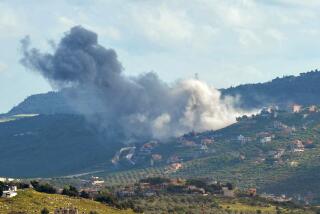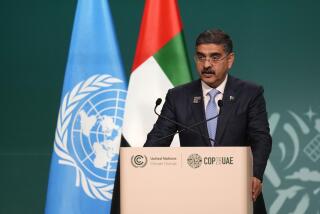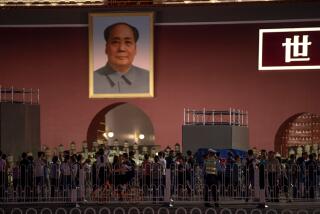Lethal Blast Near Embassy Stokes Afghan Security Fears
- Share via
KABUL, Afghanistan — A suicide bomb attack Friday on a convoy of American Humvees near the fortified U.S. Embassy, which took about 16 lives, including two soldiers’, has raised fears here about a growing ability of anti-government extremists to strike with apparent impunity, even in the capital.
Among those killed in the deadliest suicide bombing in Kabul since the Taliban fell in 2001 were six municipal street sweepers, who were finishing their morning cleaning of the neighborhood, and two young boys who sold water. As many as 20 children were hit by shattered glass as they played on narrow swaths of grass in front of an apartment complex or ate breakfast, said a doctor who treated them on the scene.
Local police said 14 civilians were killed, but hospitals registered fewer.
The bombing attack was one of four Friday in South Asia that killed civilians and underscored the continuing devastation caused by political unrest. The other blasts killed at least 29 people in India, five in Pakistan and two in Sri Lanka.
Kabul’s suicide bombing came a day before the fifth anniversary of the assassination of anti-Taliban leader Ahmed Shah Massoud, and it came just after Pakistani President Pervez Musharraf had visited Kabul and promised to try to stem the flow of militant fighters from his country into Afghanistan.
For Afghans, the bombing signaled an encroaching threat from extremists, who had been largely confined to Afghanistan’s border with Pakistan.
People in the neighborhood and across the capital blamed the incident on the Musharraf government, which they said had allowed the Taliban to take refuge, train and rearm in Pakistan. But they said the United States was responsible too because it has influence with Musharraf yet has failed to compel him to halt support for Taliban guerrillas or prevent their crossing into Afghanistan.
“We really are not happy about our neighbors, and Americans can put more pressure on Pakistan,” said former Afghan army Col. Habeeb Chopan, 43, who lives in the nearby apartment complex. “America has chosen the wrong politics in Afghanistan.”
For Abdul Majid, 35, who wept silently Friday evening in his hospital bed, the attack was a horror of loss. The municipal supervisor for the area, he is paid $66 a month and was checking on his workers when the bomber hit.
“This place was always safe. There were many soldiers nearby, but now six of my staff were killed; three were injured,” he said, struggling to sip some water without moving his shrapnel-lacerated legs and left arm.
“They were such poor people; they had so little, and I don’t know now what will happen to their families -- how will they survive?” he said.
Sher Mohammed Karimi, a deputy chief of staff for the Afghan Ministry of Defense, said the bomb was exceptionally large and a kind seen more often in the south. A suicide bombing Aug. 28 in the southern city of Lashkar Gah killed 17 and injured more than 40.
U.S. officials portrayed Friday’s blast as an expected outcome of weeks of hard fighting in the south between the Taliban and NATO forces.
“I think we have a war going on. I wouldn’t make too much of one attack or another in Kabul,” U.S. Ambassador Ronald E. Neumann said in comments broadcast on National Public Radio. “There is an attempt to give the appearance of more violence.
“I don’t detect a strong groundswell of support for the Taliban,” Neumann said. “It’s a tough fight. We need more money. We’re going to have to stay at it for a while. We are either going to abandon it to chaos or we’re going to go forward and win, but you don’t have any nice third choice.”
North Atlantic Treaty Organization defense chiefs appeared to agree that more forces were needed to fight the Taliban. As a three-day meeting began in Warsaw, a spokesman for NATO’s military committee, Canadian Col. Brett Boudreau, said the alliance was looking for about 2,000 more troops as well as equipment to help the alliance fight an increasingly fierce insurgency.
Before Friday’s bombing, the military “had information about the possibility of an attack,” acknowledged a spokesman for NATO’s International Security Assistance Force, U.S. Army Maj. Luke Knittig. “And this kind of information has helped us stop attacks in the past.
“But today we didn’t have enough.”
He said the Taliban were “showing a willingness to lash out” because of “the pressure we’re putting them under.”
“Today they targeted the international military -- in some respects it’s not unexpected. As long as we have them under pressure in the south ... it would be likely the insurgents would try to test us in the capital,” he said.
Still, Knittig said, “obviously today was pretty strong stuff.”
The suicide bomber rammed his car into one of two Humvees traveling together about 600 feet from an entrance to the U.S. Embassy, close to a roundabout known as Massoud Circle.
The blast was so strong that it left only the burning metal skeleton of the vehicle and a crater 6 feet wide. Twisted metal hung in nearby trees; tatters of U.S. military uniforms and a charred pakol, a traditional Afghan hat, were among bits of clothing scattered around the bomb site.
Shrapnel shot out in all directions, killing a woman outside a Soviet-era apartment complex where all of the windows were blown out by the blast. The sidewalk was covered with broken glass.
Some of the bodies were so damaged that relatives had difficulty identifying them, said Moussa Zayer, 28, nursing director of Wazir Akbar Khan Hospital, which has a partnership with Loma Linda University Medical Center and gives free medicine to patients.
Zayer, who was on duty when the victims began to pour in, said most of the injured had shrapnel-shattered bones and severe cuts from flying glass.
“There were two boys, their faces were cut off; they were unrecognizable,” he said. “Another boy, maybe 12 years old, was hurt in the spine. I think he will not walk again.”
Local residents said the bomb would have been far more deadly if it had come on a weekday -- Friday is Islam’s holy day, and far fewer people are on the street.
The Ministry of Health is almost next door to the U.S. Embassy, and on a weekday, hundreds of workers would have been coming and going.
*
Special correspondent Ela Kasprzycka in Warsaw contributed to this report.
More to Read
Sign up for Essential California
The most important California stories and recommendations in your inbox every morning.
You may occasionally receive promotional content from the Los Angeles Times.










